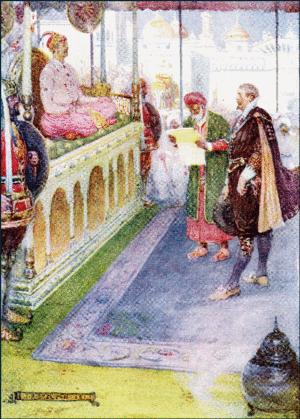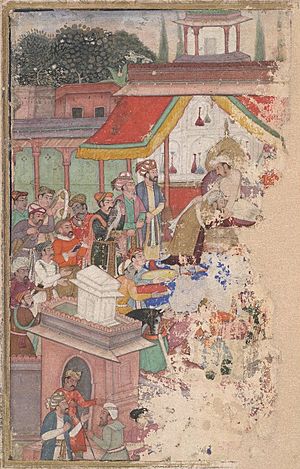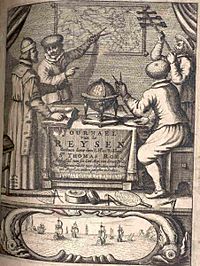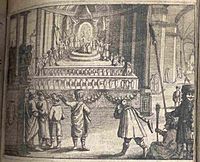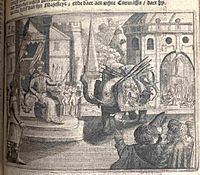Thomas Roe facts for kids
Quick facts for kids
Sir Thomas Roe
|
|
|---|---|
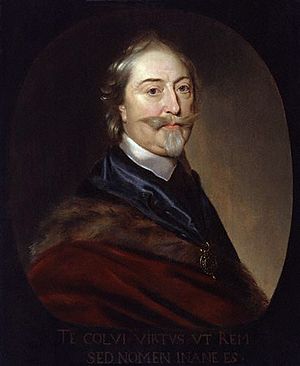 |
|
| Born | c. 1581 |
| Died | 6 November 1644 (aged 62–63) |
| Spouse(s) | Lady Eleanor Beeston |
| Parent(s) | Sir Robert Rowe Elinor Jermy |
Sir Thomas Roe (born around 1581, died 1644) was an important English diplomat. He traveled widely, from Central America to India. As an ambassador, he represented England in powerful empires. These included the Mughal Empire (India), the Ottoman Empire (Turkey), and the Holy Roman Empire (Europe). He was also a member of the English Parliament for many years. Roe was a smart scholar and supported learning.
Contents
Sir Thomas Roe's Life
Sir Thomas Roe was born in a place called Low Leyton in Essex. His father was Sir Robert Rowe, and his mother was Elinor Jermy.
When he was just twelve years old, in 1593, he started studying at Magdalen College, Oxford. Later, in 1597, he joined Middle Temple, which is a place for law students. He also became a special assistant to Queen Elizabeth I of England.
King James I made him a knight in 1604. Sir Thomas became good friends with Prince Henry, who was the King's son. He was also friends with Prince Henry's sister, Elizabeth. She later became Queen of Bohemia for a short time. Sir Thomas kept in touch with her and supported her.
Sir Thomas Roe passed away in 1644. He was about 63 years old. He was buried in the church of St. Mary in Woodford, London.
His Family
In 1614, Sir Thomas Roe married Eleanor, Lady Beeston. She was the widowed daughter of Sir Thomas Cave. They got married just weeks before he left for India.
Eleanor did not go to India with him. However, she did join him on his next trip as an ambassador to Constantinople. They did not have any children of their own. They adopted a girl named Jane Rupa, who was an orphan. Queen Elizabeth of Bohemia introduced them to Jane.
When Eleanor died in 1675, she was buried next to Sir Thomas. This was in the same church in Woodford.
Sir Thomas Roe's Career
Explorer of the Amazon
In 1610, Prince Henry sent Roe on an important trip. He went to the West Indies, visiting Guiana and the Amazon River. He was trying to find the legendary golden city of El Dorado. This city was shown on a map by Thomas Harriot in 1596.
Sir Thomas did not find the gold he was looking for. He tried again two more times, but still did not succeed.
Ambassador to India
In 1614, Sir Thomas Roe was chosen to be a Member of Parliament (MP) for Tamworth.
The East India Company asked King James to send Roe to India. He went as a royal representative to the court of the Great Mughal Emperor, Jahangir, in Agra. Roe lived in Agra for three years, until 1619.
At the Mughal court, Roe became a favorite of Emperor Jahangir. He even might have been his drinking friend. Roe arrived with gifts, including "many crates of red wine." He also explained to the Emperor "What beere was? How made?"
The main goal of his visit was to get permission for the East India Company to set up a trading post, called a factory, in Surat. Emperor Jahangir did not give many special trading rights. However, Roe's visit started a good relationship between the Mughals and the Company. This relationship grew into something like a partnership. The East India Company slowly became more involved with the Mughal Empire.
Roe kept detailed journals, which are very helpful for learning about Jahangir's rule. But the Emperor did not write about Roe in his own many diaries.
Ambassador to the Ottoman Empire
In 1621, Roe was again elected as an MP, this time for Cirencester.
He was given the job of ambassador to the Ottoman Empire in September. He arrived in Constantinople in December. In this role, he helped English merchants get more trading rights.
In 1624, he made a treaty with Algiers. This treaty helped free hundreds of English prisoners. He also got support from Prince Gabriel Bethlen of Transylvania. This prince joined the European Protestant alliance. This helped the cause of the Palatinate region.
Sir Thomas was friends with the leader of the Greek Orthodox Church, Cyril Lucaris. Because of this friendship, a very old and famous book, the Codex Alexandrinus, was given to King James I. Roe himself collected many valuable old writings. He later gave these to the Bodleian Library at Oxford University. In 1628, he gave 29 Greek and other writings to the Bodleian Library. This included an original copy of letters from the Council of Basle.
Roe also looked for ancient Greek marble sculptures. He did this for the Duke of Buckingham and the second Earl of Arundel. After his death, his wife gave 242 coins to the Bodleian Library, as he had wished.
Diplomat in the Thirty Years War
In 1629, Roe had another successful mission. He helped arrange peace between Sweden and Poland. By doing this, he helped Gustavus Adolphus of Sweden join the Thirty Years War. This was a big war in Europe. Gustavus Adolphus helped the Protestant German princes.
Roe also made agreements with cities like Danzig and with Denmark. When he returned home in 1630, a special gold medal was made in his honor. This was after he attended a meeting called the Diet of Regensburg.
Supporter of Arctic Exploration
In 1631, Sir Thomas Roe supported the Arctic explorer Luke Fox. A place in the Arctic, Roes Welcome Sound, was named after him.
English Statesman and Envoy
In January 1637, Roe was given the important job of Chancellor of the Order of the Garter. This came with a yearly payment of £1200.
In June 1640, Roe became a privy councillor. This meant he was a close advisor to the King. In November of that year, he was elected as an MP for Oxford University. This was during the Long Parliament.
He was appointed England's ambassador to the Holy Roman Empire from 1641 to 1642. He took part in peace meetings in Hamburg, Regensburg, and Vienna. He used his influence to help restore the Palatinate region. The Emperor said he had "scarcely ever met with an ambassador till now."
Sir Thomas Roe's Writings
- The Embassy of Sir Thomas Roe to the Court of the Great Mogul, 1615–1619
This book tells the story of his time as ambassador to the Mughal Emperor. It is based on his own journal and letters. It has been printed many times. A newer version was edited by William Foster. This book is a very important source of information about India in the early 1600s.
- Negotiations in his Embassy to the Ottoman Porte, 1621–28, vol. i
The first part of this work was published in 1740. Other letters about his mission to Gustavus Adolphus were edited by SR Gardiner. His letters with Lord Carew were also edited by Sir F. Maclean.
- True and Faithful Relation ... concerning the Death of Sultan Osman ... (1622)
Sir Thomas Roe published this book in 1622. He also translated a work by Paolo Sarpi.
- Discourse upon the Resolution taken in the Valteline (1628)
In 1613, Dr T Wright published Quatuor Colloquia. This book contained religious discussions between himself and Roe. A poem by Roe can be found in Notes and Queries, iv. Ser. v. 9.
- The Swedish Intelligencer (1632–33)
This book is believed to be written by Roe. It includes information about Gustavus Adolphus and the Diet of Ratisbon (Regensburg). Several of his speeches were also published. These speeches were mostly about money and financial topics. Two other writings by him are mentioned. These are Compendious Relation of the Proceedings ... of the Imperial Diet at Ratisbon and Journal of Several Proceedings of the Order of the Garter.
Modern Biographies
There are three modern books written about Sir Thomas Roe's life.


